I found myself staring at a lenticular portrait of a tree last summer at a coffee shop in Olney, IL. Actually, I was pacing back and forth in front of it because—as is the case with lenticular images—it changes. This particular image moved through the four seasons of the year as I walked by. The leaves grew in full, changed color, and dropped as the background morphed to its appropriate shades of grass and sky. I just couldn’t stop. It was arresting.
I wonder, if I had the print at home, if I wouldn’t have a single chair in front of it that I moved depending on the season. Maybe I’d choose the summer angle in the wintertime? Or the winter in the summer, who knows? I guess it would depend on my mood. I live in the Northeast US, so I’m quite familiar with the deeper varieties of all four seasons and I was quite struck by the tree’s ability to catch my eye and make me wonder for a moment. I could’ve stayed longer.
I thought of that lenticular print as I sat down to reflect upon my plays of Super Truffle Pigs, the latest title from Games by Bicycle. In truth, my interest in Super Truffle Pigs had as much to do with our family love of Bicycle’s The Alpha as it did with Jason Corace’s (Lords & Ladies) design. While I’m being honest, my long personal history with Pass the Pigs lent a hand as well. No matter the reason, the cute pigs ultimately won me over during the Kickstarter campaign, so I decided to give it a try.
Super Truffle Pigs puts players in charge of a pair of pigs scrounging the meadow for truffles, all the while avoiding the menacing wolves intent on scaring them silly. It lies at the intersection of free orthogonal swine movement and programmed wolf movement. But the real angle for viewing this game has everything to do with the attitude of the humans at the table.
Have you seen the little piggies crawling in the dirt?
Super Truffle Pigs takes place on a 4×5 grid of tiles. Several special tiles dot the landscape, including both ends of a secret pig passage, two wolves’ dens, and a handful of stone walls. Truffles are randomly placed face down according to color on the locations marked throughout the grid. A wolf movement board sits atop the grid to mark North and hold cards during their programming phase of each round. A single brown wolf is placed on the matching den facing North. Alongside the board is the deck of Super Pig Power cards, with three dealt face-up.

Each player receives a Truffle Bag board with an action marker, a set of directional cards for wolf programming, and three Mission cards. Players draft one Mission card, passing left, and then again twice more, giving each player a few targets to aim for in the meadow. Each player places their pigs on each end of the secret passage.
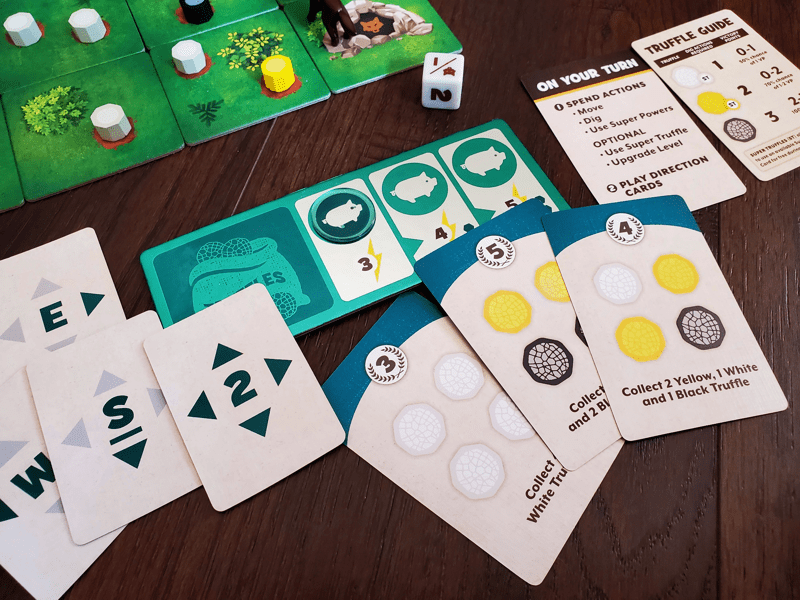
Rounds begin by rolling the Wolf die to foreshadow the coming wolf activity. If a wolf head appears, another wolf enters the landscape on its matching den. New wolves alternate between the grey and brown packs. Any rolled number indicates the number of directional cards each player will contribute to the wolves’ movement after all players have taken a turn. In the event of rolling Zzzz’s, the wolves will not move, and the piggies will rejoice.
At the outset, players have three actions to spend each turn. They may Move orthogonally one space, Dig for truffles, or play one of the Super Pig Power cards, each of which costs a certain number of actions. In addition, players may spend two captured truffles to increase their capacity for actions or reveal truffles that grant free Super Power actions.
There are three truffle colors on the board: white, yellow, and black. Each truffle has a value on the bottom and the potential increases, respectively, with the colors. Because of the shifting value, each truffle requires a different number of actions to Dig. White requires one, yellow two, and black three. To indicate the number of Dig actions spent, pigs can stand or rest on their snouts (à la Pass the Pigs) between turns.
Once each player has completed a turn, it’s time for the wolves to move. Based on the die roll from the beginning of the round, players choose cards in turn order to play face-down into the wolf board in either the brown or grey row. Once the cards are in place, they are flipped to reveal the wolves’ movement. If more than one wolf of a given color is in play, each of the wolves moves from its current location. If all four wolves happen to be on the board, they can potentially cover a lot of ground. If at any point a wolf passes through a tile with a pig, that pig is removed from the board.
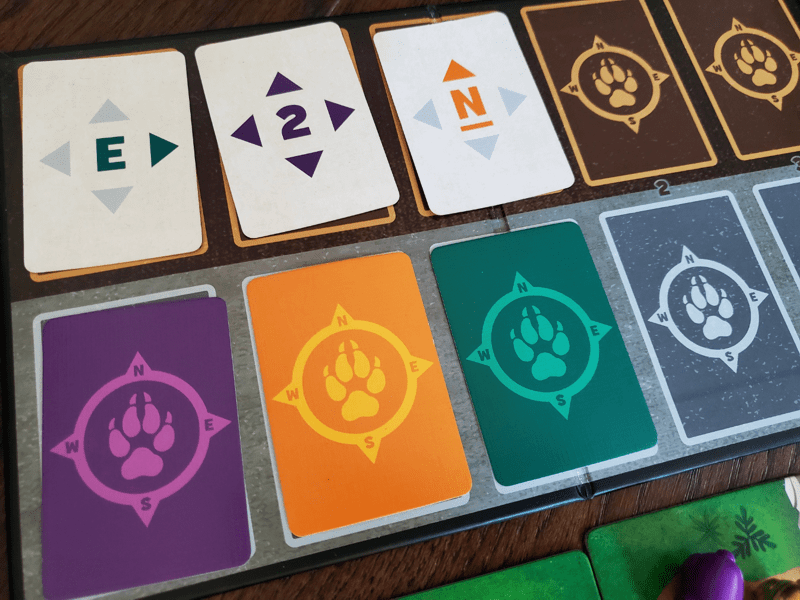
The first time a player has both of their pigs eliminated from the game, they may spend two truffles to return one pig to the meadow. They may also choose not to do so. Either way, they retain the right to contribute to wolf movement in future rounds.
If the wolf board has reached its marked capacity for cards at the end of the round, the cards are returned to their owners. If not, the cards remain on the board, leaving some players visibly without certain directional capabilities until the cards are released.
When three or fewer truffles remain on the board, or when only one lone pig remains, the game ends. Players tally the scores from their captured truffles along with any points from satisfied Mission cards. The highest score brings home the bacon?
And for all the little piggies, life is getting worse
Super Truffle Pigs is an entirely different game depending on player count and who is at the table. This indecision rests squarely on the handling of the wolves.
If you’re playing Super Truffle Pigs with your small children, you’re likely to coordinate your efforts to keep the wolves away, allowing the free gathering of the beloved truffles. Along the way, you’re hoping your kids remember their West from their East as they play cards from their hand.
If you’re playing with the more mischievous type, you may discuss such coordinated efforts. But the knife will likely come out frequently in the name of surprise swine elimination, leading to shorter games and untrusting dashes to extract truffles before the next betrayal.
If you’re playing with the ultra-competitive type, I could see the matter of the wolves being either an all-out war or an exercise in futility as the wolves are moved in frustrated circles by warring factions. East followed by West equals nothing at all. Knowing the enemy’s limitations via the direction cards stuck on the board, though, could yield a tactical advantage.
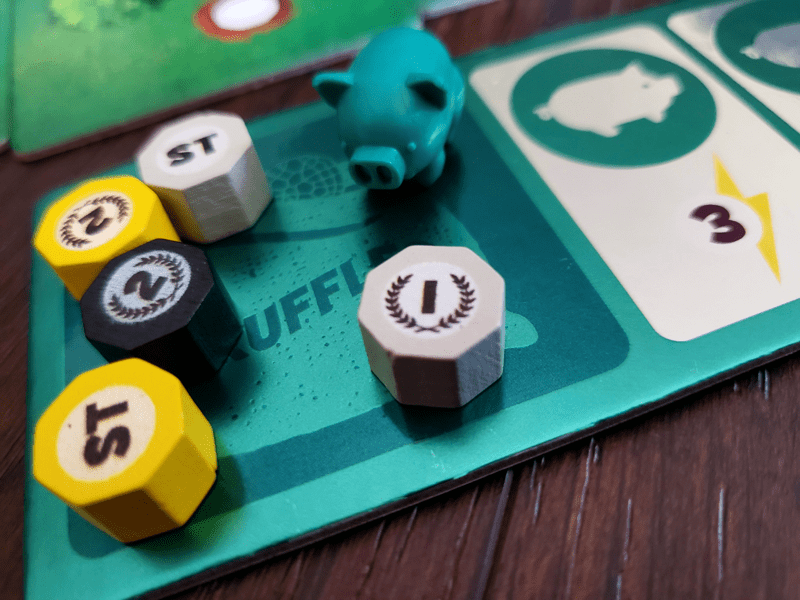
Likewise the same variety exists for the various player counts. At two players, Super Truffle Pigs only makes sense as a skirmish game using wolves as weapons. Otherwise it’s too wide open and the whole experience is reduced to digging up random victory points around the board.
At three players, there is a sweet spot for embracing randomness with the wolves, discarding all conversation about coordination and instead unleashing everyone to simply play the card they want, hoping their own contribution was enough to keep the wolves away.
At four players, with four wolves, I could easily see this becoming a semi-cooperative puzzle to control the movement of the various villains. Lingering in the background, though, is the knife mentioned above.
I find myself both celebrating and doubting this whole ordeal. This game could easily become whatever you want it to be, and in that I suppose there is something of an accomplishment. Looking for a mostly cooperative family jaunt through the meadow with only randomness to decide the winner? No problem. Want to embrace and somehow simultaneously rage against that randomness by avoiding the wolves? Sure, we’ve got that too. Are you just looking for a fist fight? Or a hoof fight? That, too, is available. The difference rests wholly in the personalities at the table.
The only thing you won’t find—and this is my doubt—is a game that is secure in its own identity. The case of very small children aside, you never really know what sort of game you’re in until it’s too late. Maybe that’s a mark of genius? Maybe the seemingly harmless pigs are designed to lull you into something innocent before revealing your true inner self, much like Bicycle’s previous outing with The Alpha. Then again, maybe not. I’m just not sure.
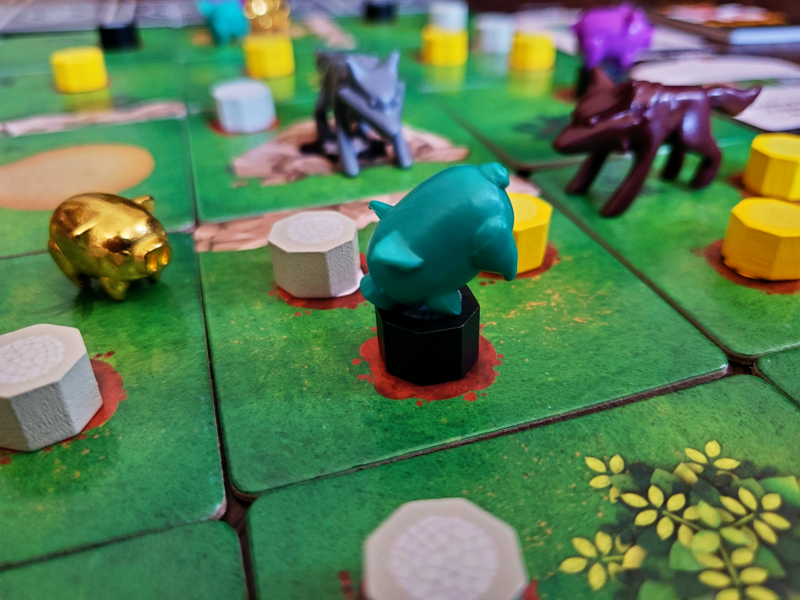
If you’re on the celebration side, know this. The components for the game are amazing. Bicycle knows how to make cards, and the rest of the components hold up as well. The Kickstarter came with two golden metal pigs capable of crushing the old school Monopoly racecar. They are heavy and heavily fought over. The ordinary pigs are a throwback to passing those classic pigs across the middle school lunch table. I love every bit and piece inside this box.
But I’m not sure I love the game. We’re not a fist-fight family, so in most cases we adopt the peaceful alternatives which are not particularly compelling. Trotting around to pick up random point tokens is too easy without the full company of wolves in play, but that can’t happen for at least a few rounds without a house rule. We rarely fail our Missions. We rarely get knocked out by the wolves. In fact, I tried for multiple rounds to eliminate pigs once and was unable because a random kid accidentally went South.
Unfortunately this one isn’t likely to stay in our collection. I celebrate its versatility, its components, and its absolutely adorable theme. But in the end, regardless of the season, I think it’s oinking up the wrong lenticular tree here.


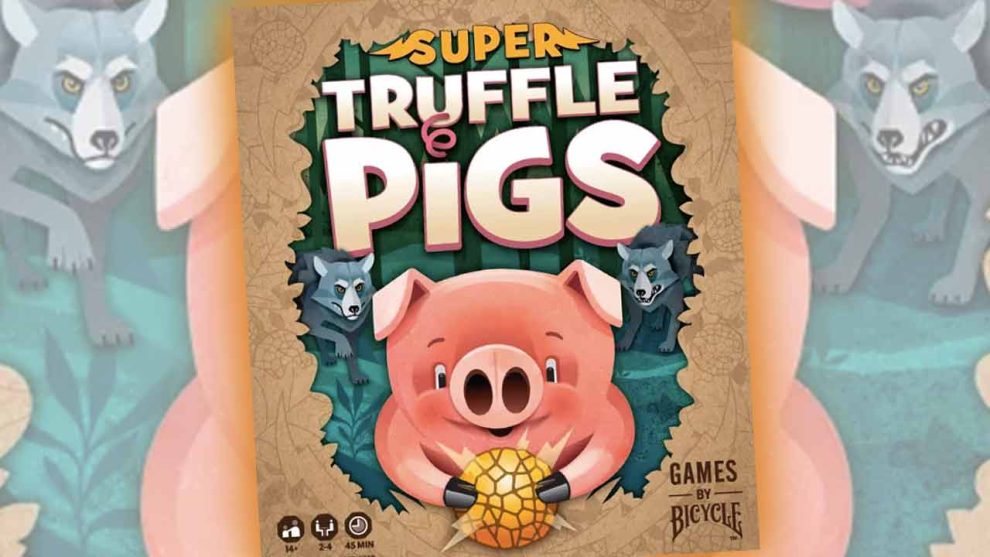
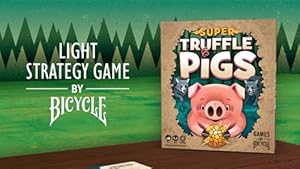








Add Comment